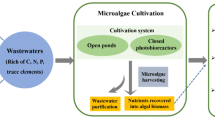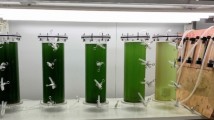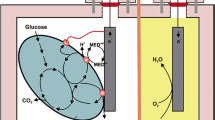Abstract
The effect of biosurfactant rhamnolipid (RL) on hydrolysis and acidification of waste activated sludge (WAS) was investigated. The results indicated that RL could greatly reduce the surface tension of sludge, resulting in stimulating the hydrolysis rate of WAS and enhancing the production of short-chain fatty acids (SCFAs). With the increase of RL dosage from 0.2 to 0.5 g/g DS, the maximum soluble chemical oxygen demand (SCOD), protein and carbohydrate concentration increased correspondingly. After 6 h of hydrolysis, SCOD, protein and carbohydrate concentration increased from 371.9, 93.3 and 9.0 mg/l to 3,994.5, 800.0 and 401.4 mg/l at RL 0.3 g/g DS, respectively. Furthermore, the release of NH4 +-N, PO4 3−-P and the accumulation of SCFAs also improved in the presence of RL. The maximum SCFAs was 1,829.9 mg COD/l at RL 0.3 g/g DS, while it was only 377.7 mg COD/l for the blank test. The propionic acid and acetic acid were the mainly SCFAs produced, accounting for 50–60% of total SCFAs.






Similar content being viewed by others
Abbreviations
- RL:
-
Biosurfactant rhamnolipid
- SCFAs:
-
Short-chain fatty acids
- WAS:
-
Waste activated sludge
- SCOD:
-
Soluble chemical oxygen demand
- TCOD:
-
Total chemical oxygen demand
- DS:
-
Dry sludge
- VSS:
-
Volatile suspended solids
- SDBS:
-
Sodium dodecylbenzene sulphonate
- SDS:
-
Sodium dodecyl sulphate
- EPS:
-
Extracellular polymeric substances
- CMC:
-
Critical micelle concentration
- ME:
-
Mixed enzyme
- TSS:
-
Total suspended solids
References
Appels, L., Baeyens, J., Degreve, J., & Dewil, R. (2008). Principles and potential of the anerobic digestion of waste-activated sludge. Progress in Energy and Combustion Science, 34, 755–781.
Lemos, P. C., Serafim, L. S., & Reis, M. A. M. (2006). Synthesis of polyhydroxyalkanoates from different short-chain fatty acids by mixed cultures submitted to aerobic dynamic feeding. Journal of Biotechnology, 122, 226–238.
Tong, J., & Chen, Y. G. (2009). Recovery of nitrogen and phosphorus from alkaline fermentation liquid of waste activated sludge and application of the fermentation liquid to promote biological municipal wastewater treatment. Water Research, 43, 2969–2976.
Eastman, J. A., & Ferguson, J. F. (1981). Solubilization of particulate organic carbon during the acid phase of anaerobic digestion. Journal - Water Pollution Control Federation, 53, 352–366.
Czechowski, F., & Marcinkowski, K. (2006). Sewage sludge stabilisation with calcium hydroxide: effect on physicochemical properties and molecular composition. Water Research, 40, 1895–1905.
Muller, J. A. (2001). Prospects and problems of sludge pre-treatment processes. Water Sci. Technology, 44, 121–128.
Yang, Q., Luo, K., Li, X. M., Wang, D. B., Zheng, W., Zeng, G. M., & Liu, J. J. (2010). Enhanced efficiency of biological excess sludge hydrolysis under anaerobic digestion by additional enzymes. Bioresource Technology, 101, 2924–2930.
Liwarska-Bizukojc, E., & Bizukojc, M. (2006). Effect of selected anionic surfactants on activated sludge flocs. Enzyme and Microbial Technology, 39, 660–668.
Jiang, S., Chen, Y. G., & Zhou, Q. (2007). Effect of sodium dodecyl sulfate on waste activated sludge hydrolysis and acidification. Chemical Engineering Journal, 132, 311–317.
Wang, H. Y., Fan, B. Q., Li, C. H., & Liu, M. (2011). Effects of rhamnolipid on the cellulase and xylanase in hydrolysis of wheat straw. Bioresource Technology, 102, 6515–6521.
Thangamani, S., & Shreve, G. S. (1994). Effect of anionic biosurfactant on hexadecane partitioning in multiphase systems. Environmental Science and Technology, 28, 1993–2000.
Banat, I. M., Makkar, R. S., & Cameotra, S. S. (2000). Potential commercial applications of microbial surfactants. Applied Microbiology and Biotechnology, 53, 495–508.
APHA, AWWA, WEF. (2005). Standard methods, 19th ed. Washington, DC, USA
Herbert, D., Philipps, P. J., & Strange, R. E. (1971). Carbohydrate analysis. Methods in Enzymology, 5B, 265–277.
Lowry, O. H., Rosebrough, N. J., Farr, A. L., & Randall, R. J. (1951). Protein measurement with the Folin phenol reagent. Journal of Biological Chemistry, 193, 265–275.
Luo, K., Yang, Q., Yu, J., Li, X. M., Yang, G. J., Xie, B. X., Yang, F., Zheng, W., & Zeng, G. M. (2011). Combined effect of sodium dodecyl sulfate and enzyme on waste activated sludge hydrolysis and acidification. Bioresource Technology, 102, 7103–7110.
Liu, H., & Fang, H. H. P. (2002). Extraction of extracellular polymeric substances (EPS) of sludges. Journal of Biotechnology, 95, 249–256.
Vavilin, V. A., Rytov, S. V., & Lokshina, L. Y. (1996). A description of hydrolysis kinetics in anaerobic degradation of particulate organic matter. Bioresource Technology, 56, 229–237.
Helle, S. S., Duff, S. J. B., & Cooper, D. G. (1993). Effect of surfactants on cellulose hydrolysis. Biotechnology and Bioengineering, 42, 611–617.
Feitkenhauer, H., & Meyer, U. (2002). Anaerobic digestion of alcohol sulfate (anionic surfactant) rich wastewater-batch experiments: Part I. Influence of the surfactant concentration. Bioresour. Technol, 82, 115–121.
Mayer, A. S., Zhong, L., & Pope, G. A. (1999). Measurement of mass-transfer rates for surfactant-enhanced solubilization of nonaqueous phase liquids. Environmental Science and Technology, 33, 2965–2972.
Sotirova, A., Spasova, D., Vasileva-Tonkova, E., & Galabova, D. (2009). Effects of rhamnolipid-biosurfactant on cell surface of Pseudomonas aeruginosa. Microbiology Research, 164, 297–303.
Ji, R., & Brune, A. (2005). Digestion of peptidic residues in humic substances by an alkali-stable and humic-acid-tolerant proteolytic activity in the gut of soil-feeding termites. Soil Biology & Biochemistry, 37, 1648–1655.
Chen, Y., Cheng, J. J., & Creamer, K. S. (2008). Inhibition of anaerobic digestion process: a review. Bioresource Technology, 99, 4044–4064.
Ji, Z. Y., Chen, G. L., & Chen, Y. G. (2010). Effects of waste activated sludge and surfactant addition on primary sludge hydrolysis and short-chain fatty acids accumulation. Bioresource Technology, 101, 3457–3462.
Yu, H. Q., Zheng, X. J., Hu, Z. H., & Gu, G. W. (2003). High-rate anaerobic hydrolysis and acidogenesis of sewage sludge in a modified upflow reactor. Water Science and Technology, 48, 69–75.
Jiang, S., Chen, Y. G., Zhou, Q., & Gu, G. W. (2007). Biological short-chain fatty acids (SCFAs) production from waste-activated sludge affected by surfactant. Water Research, 41, 3112–3120.
Chen, Y. G., Jiang, S., Yuan, H. Y., Zhou, Q., & Gu, G. W. (2007). Hydrolysis and acidification of waste activated sludge at different pHs. Water Research, 41, 683–689.
Kayhanian, M. (1994). Performance of a high-solids anaerobic digestion process under various ammonia concentrations. Journal of Chemical Technology and Biotechnology, 59, 349–352.
Mclnerney, M. J., Struchtemeyer, C. G., Sieber, J., Mouttaki, H., Stams, A. J. M., Schink, B., Rohlin, L., & Gunsalus, R. P. (2008). Physiology, ecology, phylogeny, and genomics of microorganisms capable of syntrophic metabolism. Annual New York Academy of Sciences, 1125, 58–72.
Feng, L. Y., Chen, Y. G., & Zheng, X. (2009). Enhancement of waste activated sludge protein conversion and volatile fatty acids accumulation during waste activated sludge anaerobic fermentation by carbohydrate substrate addition: the effect of pH. Environmental Science and Technology, 43, 4373–4380.
Suwannakham, S., & Yang, S. T. (2005). Enhanced propionic acid fermentation by Propionibacterium acidipropionici mutant obtained by adaptation in a fibrous-bed bioreactor. Biotechnology and Bioengineering, 91, 325–337.
Luo, K., Yang, Q., Li, X. M., Chen, H. B., Liu, X., Yang, G. J., & Zeng, G. M. (2013). Novel insights into enzymatic-enhanced anaerobic digestion of waste activated sludge by three-dimensional excitation and emission matrix fluorescence spectroscopy. Chemosphere, 91, 579–585.
Chen, Y. G., Randall, A. A., & McCue, T. (2004). The efficiency of enhanced biological phosphorus removal from real wastewater affected by different ratios of acetic to propionic acid. Water Research, 38, 27–36.
Wang, Q., Kuninobu, M., Ogawa, H. I., & Kato, Y. (1999). Degradation of volatile fatty acids in highly efficient anaerobic digestion. Biomass and Bioenergy, 16, 407–416.
Sarney, D. B., & Vulfson, E. N. (1995). Application of enzymes to the synthesis of surfactants. Trends in Biotechnology, 13, 164–172.
Acknowledgements
This research was financially supported by the project of National Natural Science Foundation of China (No. 51078128), International Science and Technology Cooperation Program of China (No. 2011DFA90740), Planned Science and Technology Project of Hunan Province, China (No. 2011SK3215), and the Key Laboratory of Renewable Energy Electric-Technology of Hunan Province (No. 2012KFJJ007).
Author information
Authors and Affiliations
Corresponding authors
Rights and permissions
About this article
Cite this article
Yi, X., Luo, K., Yang, Q. et al. Enhanced Hydrolysis and Acidification of Waste Activated Sludge by Biosurfactant Rhamnolipid. Appl Biochem Biotechnol 171, 1416–1428 (2013). https://doi.org/10.1007/s12010-013-0439-0
Received:
Accepted:
Published:
Issue Date:
DOI: https://doi.org/10.1007/s12010-013-0439-0




